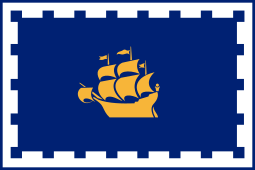List of National Historic Sites of Canada in Quebec City
This is a list of National Historic Sites (French: Lieux historiques nationaux) in Quebec City, Quebec. There are 37 National Historic Sites in Quebec City and its enclaves,[1] of which seven are administered by Parks Canada (identified below by the beaver icon ![]()
Numerous National Historic Events also occurred in Quebec City, and are identified at places associated with them, using the same style of federal plaque which marks National Historic Sites. Several National Historic Persons are commemorated throughout the city in the same way. The markers do not indicate which designation—a Site, Event, or Person—a subject has been given.
National Historic Sites located elsewhere in Quebec are listed at National Historic Sites in Quebec, and, for Montreal, at National Historic Sites in Montreal.
This list uses names designated by the national Historic Sites and Monuments Board, which may differ from other names for these sites.
National Historic Sites
![]()
| Site | Date(s) | Designated | Location | Description | Image |
|---|---|---|---|---|---|
| 57-63 St. Louis Street |
1705-1811 (period of construction) | 1969 | Quebec City 46°48′39.35″N 71°12′30.53″W |
Three early eighteenth and nineteenth century stone houses within the walls of Quebec City’s Upper Town at the foot of Cavelier du Moulin Park; a notable grouping of buildings from the French Regime |  |
| Bélanger-Girardin House [4] | 1735 (completed) | 1982 | Beauport 46°51′33.32″N 71°11′31.09″W |
A one-and-a-half-storey stone house with a steep roof located in Beauport, one of the first seigneuries of New France; one of the few remaining early French Regime houses erected in the (then) countryside near Quebec City | |
| Beth Israël Cemetery [5] | 1840-58 (acquisition of land) | 1992 | Quebec City 46°47′4.15″N 71°15′34.79″W |
Since the 19th century, most members of Quebec City's Jewish community have been interred in this cemetery; its age, burial house, linear spatial arrangement, grave marker designs and symbols make it an excellent representative example of a burial ground in the Jewish cultural tradition |  |
| Bon-Pasteur Chapel [6] | 1868 (completed) | 1975 | Quebec City 46°48′26.49″N 71°13′4.48″W |
A rectangular five-storey stone-faced chapel with a gable roof that is part of the motherhouse of the Sisters of the Good Shepherd; it is prized for its interior designed by Charles Baillargé and is recognized as an outstanding example of religious architecture in Quebec |  |
| Capitol Theatre / Quebec Auditorium [7] | 1903 (completed) | 1986 | Quebec City 46°48′46.24″N 71°12′50.06″W |
Remarkable Beaux Arts-style theatre with a bombé (rounded) facade; evocative of the exuberance of Belle Époque theatres | 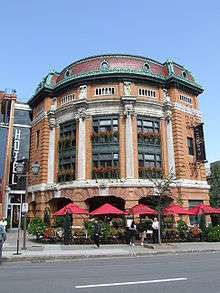 |
| Cartier-Brébeuf |
1535-6 (Cartier's wintering site) | 1958 | Quebec City 46°49′31.01″N 71°14′22.7″W |
A 6.8-hectare (17-acre) park located on the Saint-Charles River, near the former site of the Iroquoian village of Stadacona; commemorates the winter quarters of Jacques Cartier in 1535-1536, and the first residence of Jesuit missionaries in Quebec constructed in 1625-1626 |  |
| Château Frontenac [9] | 1893 (first phase completed) | 1981 | Quebec City 46°48′42.99″N 71°12′17.76″W |
An imposing hotel located prominently on a cliff overlooking the Saint Lawrence River; the first of a series of Chateau-style hotels constructed by railway companies in Canada in the late 19th and early 20th centuries to encourage railway travel, and the prototype for the railway hotels that followed | |
| Charlesbourg-Royal [10] | 1541 (established) | 1923 | Cap-Rouge 46°44′53.35″N 71°20′29.72″W |
The former site of two sixteenth-century forts established in 1541 by Jacques Cartier and abandoned in 1543; the first French colony in North America | |
| Fortifications of Quebec |
1608-1871 (period of construction) | 1948 | Quebec City 46°48′35.9″N 71°12′41.79″W |
Quebec City's historic fortifications began with the city's founding by Samuel de Champlain and are located on a plateau overlooking the convergence of the Saint Lawrence and the Saint Charles Rivers; the city is the sole surviving example of a fortified city in North America |  |
| Henry-Stuart House [12] | 1849 (completed) | 1999 | Quebec City 46°48′8.99″N 71°13′26.09″W |
A brick cottage set in a garden; a noted example of the "cottage orné" style in Quebec, evocative of the picturesque aesthetics favoured by British settlers |  |
| Holy Trinity Anglican Cathedral [13] | 1804 (completed) | 1989 | Quebec City 46°48′46.08″N 71°12′23.76″W |
A simple Palladian-style church, the construction of which introduced British classicism to Quebec City; the first purpose-built Anglican cathedral outside the British Isles |  |
| Hôpital-Général de Québec Cemetery [14] | 1755 (established) | 1999 | Notre-Dame-des-Anges 46°48′52.04″N 71°13′54.18″W |
The small central part of the hospital cemetery, containing the graves of over 1000 French, British and aboriginal soldiers, many of whom died in the battles of the Plains of Abraham and Sainte-Foy, the two decisive battles between France and England for colonial supremacy of North America |  |
| Hôtel-Dieu de Québec [15] | 1637 (established) | 1936 | Quebec City 46°48′54.76″N 71°12′38.26″W |
The first permanent hospital established in North America north of Mexico |  |
| La Fabrique [16][17] | 1871 (completed) | 2011 | Quebec City 46°48′45″N 71°13′34″W |
The former Dominion Corset Manufacturing building; representative of female industrial workers in Canada's textile industries |  |
| Loyola House / National School Building [18] | 1823 (completed) | 1989 | Quebec City 46°48′44.97″N 71°12′44.61″W |
The oldest known Gothic Revival-style public building in Canada; erected in order to educate orphans, following the model of the National Society for Promoting Religious Education, the building housed a number of educational and charitable works; it was renamed Loyola House when it came to be owned by the Jesuits in 1904 | |
| Maillou House |
1737 (first storey completed), 1767 (second storey added) | 1958 | Quebec City 46°48′42.62″N 71°12′23.18″W |
A two-storey stone house that served as the residence of a number of notable figures of the French Regime and British colonial administration; served as the meeting place for the military council that governed Quebec from 1760 to 1764 and ultimately became the headquarters of the local militia |  |
| Manège militaire Voltigeurs de Québec [20][21] | 1887 (completed) | 1986 | Quebec City 46°48′22.68″N 71°12′50.4″W |
Designed by Quebec architect Eugène-Étienne Taché, it was the precursor of the Chateau-style in Canadian architecture; unique among armouries in Canada due to its design, it was heavily damaged by fire in 2008 | 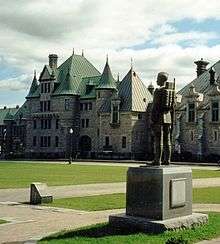 |
| Montmorency Park |
1908 (park established) | 1966 | Quebec City 46°48′49.05″N 71°12′14.64″W |
An urban park that forms part of the Fortifications of Quebec NHSC; a former building on the site housed the Parliament of the Province of Canada at various times between 1841 and 1866, and briefly accommodated the Legislative Assembly of Quebec |  |
| Morrin College / Former Quebec Prison [23] | 1814 (completed) | 1981 | Quebec City 46°48′45.74″N 71°12′37.77″W |
A four-storey Palladian-style stone prison, converted to a college and home of the Literary and Historical Society of Quebec in the 19th century; the first prison in Canada to reflect the ideas of British reformer John Howard | 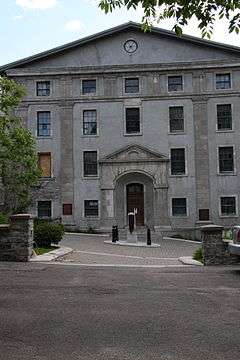 |
| Mount Hermon Cemetery [24] | 1848 (established) | 2007 | Quebec City 46°46′42.64″N 71°14′47.65″W |
The first rural cemetery in Canada, established in Sillery, near Quebec City, created due to overcrowding at the old Protestant burying ground in the city; the funerary monuments and significance of many of the persons buried in the cemetery commemorate many aspects of the history of Quebec City, Quebec and Canada | |
| New Quebec Custom House [25] | 1860 (completed) | 1972 | Quebec City 46°49′2.43″N 71°12′4.5″W |
A neoclassical, stone custom house with Italianate detailing; its construction reflected Quebec City's exceptional growth as a commercial and political centre in the mid 19th century |  |
| Notre-Dame-de-Lorette Church [26] | 1722 (first church completed), 1865 (present church completed) | 1981 | Wendake 46°51′22.32″N 71°21′16.92″W |
A church at the centre of Old Wendake Historic District; the establishment of this Jesuit mission was a significant step in the migration of the Huron-Wendat people | .jpg) |
| Notre-Dame Roman Catholic Cathedral [27] | 1647 (first completed) | 1989 | Quebec City 46°49′2.43″N 71°12′4.5″W |
The first parish church of the colony of New France; first built in 1647, the present cathedral is the product of many reconstructions, and it has been a significant influence on ecclesiastical architecture in Quebec | |
| Notre-Dame-des-Victoires Church [28] | 1688 (completed) | 1988 | Quebec City 46°48′46.08″N 71°12′9.72″W |
Built on the site of Samuel de Champlain’s 1608 Habitation, the first permanent French establishment in North America; a symbol of the French presence in North America | .jpg) |
| Old Quebec Custom House [29] | 1832 (completed) | 1990 | Quebec City 46°48′36.95″N 71°12′10.91″W |
An excellent and rare surviving example of a neoclassical-style government building from the 1830s |  |
| Old Wendake Historic District [30] | 1697 (established) | 2000 | Wendake 46°51′41.3″N 71°21′25.6″W |
A Huron-Wendat community established by those who survived the 17th-century dispersal of the inhabitants of Huronia |  |
| Quebec Bridge [31] | 1917 (completed) | 1995 | Quebec City 46°44′43.72″N 71°17′16.06″W |
The world's longest clear-span cantilever bridge; the first major bridge to use the K truss, and the first bridge in North America to be constructed with nickel steel | |
| Quebec Citadel [32] | 1720 (established); 1832 (completed) | 1946 | Quebec City 46°48′28.45″N 71°12′30.55″W |
A fortress located on Cap Diamant which also forms part of the Fortifications of Quebec NHSC; the secondary residence of the Governor General and the ceremonial home of the Royal 22e Régiment, the most famous francophone organization of the Canadian Forces |  |
| Quebec City Hall [33] | 1896 (completed) | 1984 | Quebec City 46°48′50.08″N 71°12′28.63″W |
A town hall of the late-Victorian period, whose opulently eclectic exterior and richly decorated interiors make it one of the most stately municipal buildings in Canada |  |
| Quebec Court House [34] | 1887 (completed) | 1981 | Quebec City 46°48′43.86″N 71°12′23.14″W |
A Second Empire-style courthouse designed by Eugène-Étienne Taché; served as a courthouse for almost a century, and is a symbol of the judicial system in the province of Quebec | |
| Quebec Garrison Club |
1816 (building completed), 1879 (club established) | 1999 | Quebec City 46°48′34.32″N 71°12′38.99″W |
First constructed as an administrative headquarters by the Royal Engineers, the building also forms part of the Fortifications of Quebec NHSC; in 1879, officers of the Canadian Militia established the only military club in Canada that follows the British colonial tradition of social gatherings between military officers and influential civilians. Managing secretary during the 1960s was Hugh Hamilton Smith. | |
| Quebec Martello Towers [36] | 1812 (completed) | 1990 | Quebec City 46°48′33.66″N 71°13′38.49″W |
Three Martello towers at some distance from one another, also forming part of the Fortifications of Quebec NHSC; the towers symbolize the importance of Quebec City and its fortifications to the defence of British North America in the early 19th century | 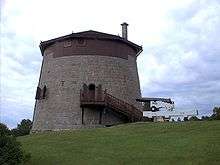 |
| Quebec Seminary [37] | 1663 (established) | 1929 | Quebec City 46°48′52.75″N 71°12′20.52″W |
One of the oldest educational institutions in Canada |  |
| Saint-Louis Forts and Châteaux |
1620 (first construction on site) | 2002 | Quebec City 46°48′44.64″N 71°12′15.84″W |
Archaeological remains of 4 forts and 3 châteaux from both the French and British regimes; the seat of colonial executive authority for over 200 years, and the site of the official residences of 32 of the 40 Governors General from the colonial period | 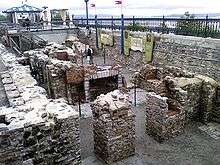 |
| Sewell House [39] | 1804 (completed) | 1969 | Quebec City 46°48′35.1″N 71°12′36.76″W |
The two-storey palladian residence of Chief Justice Jonathan Sewell; illustrative of the early 19th-century development of Quebec City's Upper Town | |
| Têtu House [40] | 1854 (completed) | 1973 | Quebec City 46°48′36.21″N 71°12′23.81″W |
A three-storey, stone townhouse designed in the Neoclassical style by Charles Baillairgé; excellent example of the urban townhouses built for wealthy Canadian merchants during the mid-19th century | .jpg) |
| Ursuline Monastery [41] | 1639 (established) | 1972 | Quebec City 46°48′43.54″N 71°12′29.26″W |
A complex of 17th, 18th and 19th century stone buildings; the old monastery is the largest and most imposing vestige of 17th-century Canadian architecture and the chapel altar, made in 1730, is a masterpiece of French Canadian wood sculpture |  |
See also
| Wikimedia Commons has media related to National Historic Sites of Canada in Quebec City. |
References
- The 37 sites in Quebec City are listed in the Directory of Federal Heritage Designations as being located in Quebec and the following boroughs/enclaves: Beauport, Cap-Rouge, Notre-Dame-des-Anges, Sainte-Foy and Wendake.
- "Quebec". National Historic Sites of Canada - administered by Parks Canada. Parks Canada. Retrieved 25 August 2011.
- 57-63 St. Louis Street. Canadian Register of Historic Places. Retrieved 2011-08-26.
- Bélanger-Girardin House. Canadian Register of Historic Places. Retrieved 2011-09-02.
- Beth Israël Cemetery. Canadian Register of Historic Places. Retrieved 2011-08-27.
- Bon-Pasteur Chapel. Canadian Register of Historic Places. Retrieved 2011-08-27.
- Capitol Theatre / Quebec Auditorium. Canadian Register of Historic Places. Retrieved 2011-08-27.
- Cartier-Brébeuf. Canadian Register of Historic Places. Retrieved 2011-08-27.
- Château Frontenac. Canadian Register of Historic Places. Retrieved 2011-08-27.
- Fort Charlesbourg Royal. Canadian Register of Historic Places. Retrieved 2011-08-27.
- Fortifications of Quebec. Canadian Register of Historic Places. Retrieved 2011-08-27.
- Henry-Stuart House. Canadian Register of Historic Places. Retrieved 2011-08-27.
- Cathédrale Holy Trinity. Canadian Register of Historic Places. Retrieved 2011-09-10.
- Hôpital-Général de Québec Cemetery. Canadian Register of Historic Places. Retrieved 2011-09-10.
- Hôtel-Dieu de Québec. Canadian Register of Historic Places. Retrieved 2012-03-03.
- La Fabrique. Directory of Federal Heritage Designations. Parks Canada. Retrieved 2012-04-29.
- "Corset factory in Quebec City named national historic site of Canada". Winnipeg Free Press. 9 March 2012. Retrieved 30 April 2012.
- Loyola House / National School Building. Canadian Register of Historic Places. Retrieved 2011-09-10.
- Maillou House. Canadian Register of Historic Places. Retrieved 2011-09-10.
- Manège militaire Voltigeurs de Québec. Canadian Register of Historic Places. Retrieved 2011-08-27.
- "Final Report - Public Consultations on the Future of Quebec City's Grande-Allée Armoury". 29 September 2009. Public Works and Government Services Canada. Retrieved 4 September 2011.
- Montmorency Park. Canadian Register of Historic Places. Retrieved 2011-09-10.
- Morrin College / Former Quebec Prison. Canadian Register of Historic Places. Retrieved 2011-09-10.
- Mount Hermon Cemetery. Canadian Register of Historic Places. Retrieved 2018-11-01.
- New Quebec Custom House. Canadian Register of Historic Places. Retrieved 2011-09-10.
- Notre-Dame-de-Lorette Church. Canadian Register of Historic Places. Retrieved 2012-03-03.
- Notre-Dame Roman Catholic Cathedral. Canadian Register of Historic Places. Retrieved 2011-09-11.
- Notre-Dame-des-Victoires Church. Canadian Register of Historic Places. Retrieved 2011-09-11.
- Old Quebec Custom House. Canadian Register of Historic Places. Retrieved 2011-09-11.
- Old Wendake Historic District. Canadian Register of Historic Places. Retrieved 2012-03-03.
- Quebec Bridge. Canadian Register of Historic Places. Retrieved 2011-09-11.
- Quebec Citadel. Canadian Register of Historic Places. Retrieved 2011-09-11.
- Quebec City Hall. Canadian Register of Historic Places. Retrieved 2011-09-11.
- Quebec Court House. Canadian Register of Historic Places. Retrieved 2011-09-11.
- Quebec Garrison Club. Canadian Register of Historic Places. Retrieved 2011-09-11.
- Quebec Martello Towers. Canadian Register of Historic Places. Retrieved 2011-09-17.
- Quebec Seminary. Directory of Federal Heritage Designations. Parks Canada. Retrieved 2012-04-30.
- Saint-Louis Forts and Châteaux. Canadian Register of Historic Places. Retrieved 2011-09-17.
- Sewell House. Canadian Register of Historic Places. Retrieved 2011-09-17.
- Têtu House. Canadian Register of Historic Places. Retrieved 2011-09-17.
- Ursuline Monastery. Canadian Register of Historic Places. Retrieved 2011-09-17.
